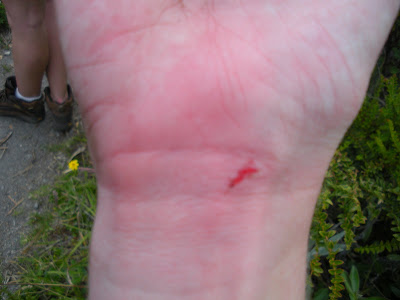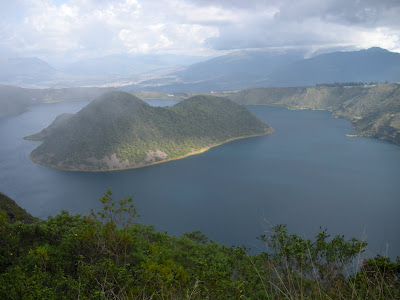WHAT a day. After a very interesting Saturday (details to come) I woke up early to get a head start on some homework for Monday. Too bad none of the internet cafés open until 10am at the earliest. By about 11:30, I had finished up and was on my way with Amanda to meet Tom to go climb the Basilica of the National Vow. This was a find of Tom’s from last Sunday, which he described as kind of scary but worth it.

KIND OF??

Sidenote: I am afraid of many things. Heights, great speed, tight spaces, clowns, etc. Normally, in places like theme parks or rope courses at summer camp, I can reason my way out of fear using the line of rational that if the risk was great enough that I have a reason to be afraid, then no insurance company stand behind that activity and if there had been an accident in the past, the company would have been sued for all they were worth. Definitely an upside of living in such a litigious society. Unfortunately, this line of reasoning tends to break down outside the good old US of A.

The Basilica is first and foremost an incredible cathedral. Not knowing much about church construction, I do know that walking up the steep park to the entrance, one feels what its original architects intended: awe at the scale and magnificence of the monument. And, unlike most great cathedrals elsewhere in the world, you can poke around most anywhere inside. Including two of the three great spires.

A few flights of stairs up, and one arrives at the first major stopping point – a wide open area along the front width of the church that houses the organ and some amazing stained glass work. From here, one can view the expanse of the nave below. Strangely enough that was the one place in the church where we were not allowed. Another flight up, and we were above the ceiling of the nave – literally. From the floor directly above the first stopping point, a rickety wooden bridge with two rope handrails extends over the arches that form the ceiling of the nave. The stone slopes down to meet with the walls, making it a soft tumble of about 15 feet if one were to, say, put a foot through the wooden planks that creak with every step. Sadly, this is the easy part.


The bridge, now over the front of the nave, ends in a small wooden platform, with a nearly vertical ladder leading up about a story. Chicken wire forms a cage over the back of each step, preventing one from putting a foot through the stepladder and slipping. Upon submitting the ladder, one is now fully outside, along the bas of the smallest spire. (‘Small’, of course, is relative.) Two flying buttresses support the breadth of the spire. Along the outermost buttress, two more flights of ladders wind around to the top platform of the spire. The first ladder is much steeper than the second, but hovers directly over a very solid-looking roof. The second flight turns 180 degrees back towards the spire, but hangs over… well, to think of it now, I’m not really sure because after one quick glance I was done looking. Also, the chicken wire ends about four steps from the top. Sure, it’s easy to think of chicken wire as unsubstantial support, but just wait until it’s taken from you with no warning. I’ll never look at lawn ornaments made from chicken wire the same again.


Okay, dramatics aside, the view was pretty much the most incredible thing ever. Quito is a very unique city in that most buildings are only a few stories high, the largest ones twenty at most. It stretches down the length of the valley, long and thin, like someone poured orange-and-beige buildings into the valley and they came to rest in a lake of urban settlement. At the far southern end, the giant statue of the virgin stands guard over Quito from what must be a man-made hill, so perfectly placed as a stopper to keep all of those buildings from flowing right out of their lake. We didn’t stay for too long, however, since as Tom remarked, “Wow. This is not significantly less scary the second time around.”

We scooted down the three ladders, lightly stepped across the bridge, and returned to the safety of wide stone floors with walls and normal-people stairs. Or so we thought. A not-at-all touristy gift shop stood at the opposite end of the floor, with a flight of stairs leading up from one wall. It led to a very classy café, with yet another flight of stairs going higher still. It became apparent that we were not only able but expected to ascend to the belfry in one of the twin towers that formed the imposing front entrance of the cathedral.

Why the hell not.
First, a green spiral staircase led up three white-knuckled floors, passing the original clock machinery that used to run the white-and-blue clocks, the faces of which were at least twice as tall as I am. We passed these clocks as well, and the four or so bells on the floor above, and FINALLY reached the upper-most floor by way of two very suspect-looking rebar ladders (no chicken wire this time, but at least we were inside).
Admittedly, this climb was not as bad as the first. Instead of a bloody and crunchy death, the worst that could happen was a rough fall from slipping on one of the ladders. Still, by the time Tom, Amanda, and I descended, there were lots of shaky legs. And hugs. Many hugs.

Tom headed home to join his family for lunch, and Amanda and I wandered back through Quito, first looking at a small part of the very large Sunday art fair in el Parque Ejido, and then unsuccessfully searching for a yarn store where I needed to buy materials for my weaving class. Later, Tom, Molly and I will meet back up to work on an Economía Ambiental project, and I’ll get online to post this!
View of the first tower we climbed, as seen from the second
















































